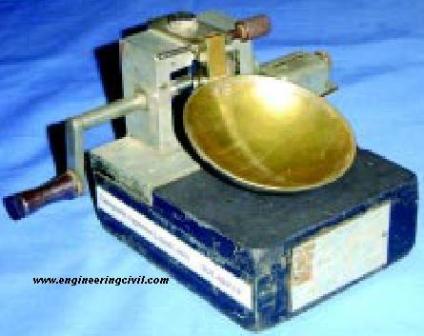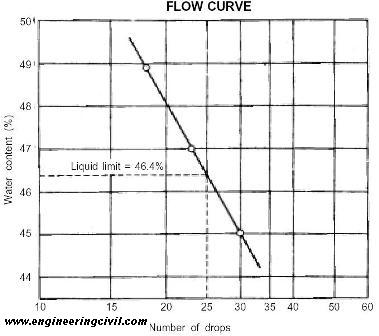This test is done to determine the liquid limit of soil as per IS: 2720 (Part 5) – 1985. The liquid limit of fine-grained soil is the water content at which soil behaves practically like a liquid, but has small shear
strength. It’s flow closes the groove in just 25 blows in Casagrande’s liquid limit device. The apparatus used :-
i) Casagrande’s liquid limit device
ii) Grooving tools of both standard and ASTM types
iii) Oven
iv) Evaporating dish
v) Spatula
vi) IS Sieve of size 425µm
vii) Weighing balance, with 0.01g accuracy
viii) Wash bottle
ix) Air-tight and non-corrodible container for determination of moisture content
PREPARATION OF SAMPLE
i) Air-dry the soil sample and break the clods. Remove the organic matter like tree roots, pieces of bark, etc.
ii) About 100g of the specimen passing through 425µm IS Sieve is mixed thoroughly with distilled water in the evaporating dish and left for 24hrs. for soaking.

Procedure to Determine The Liquid Limit Of Soil
i) Place a portion of the paste in the cup of the liquid limit device.
ii) Level the mix so as to have a maximum depth of 1cm.
iii) Draw the grooving tool through the sample along the symmetrical axis of the cup, holding the tool perpendicular to the cup.
iv) For normal fine grained soil: The Casagrande’s tool is used to cut a groove 2mm wide at the bottom, 11mm wide at the top and 8mm deep.
v) For sandy soil: The ASTM tool is used to cut a groove 2mm wide at the bottom, 13.6mm wide at the top and 10mm deep.
vi) After the soil pat has been cut by a proper grooving tool, the handle is rotated at the rate of about 2 revolutions per second and the no. of blows counted, till the two parts of the soil sample come into contact for about 10mm length.
vii) Take about 10g of soil near the closed groove and determine its water content
viii) The soil of the cup is transferred to the dish containing the soil paste and mixed thoroughly after adding a little more water. Repeat the test.
ix) By altering the water content of the soil and repeating the foregoing operations, obtain at least 5 readings in the range of 15 to 35 blows. Don’t mix dry soil to change its consistency.
x) Liquid limit is determined by plotting a ‘flow curve’ on a semi-log graph, with no. of blows as abscissa (log scale) and the water content as ordinate and drawing the best straight line through the plotted points.
REPORTING OF RESULTS
Report the water content corresponding to 25 blows, read from the ‘flow curve’ as the liquid limit.
A sample ‘flow curve’ is given as

If you have a query, you can ask a question here.



Very useful information and guidance found.
ya good information
jyothi could you please tell me the how they taken number of drops how they marked in graph as 10 15 20 like
8.95-7.46-9.86-
50-30-21
thank u very much
Thank you very much for all the info. I get what I wanted for all my civil engineering labs. very straight forward in easy to comprehend. God bless you.
Thank you very much , am so excited with your informations. It is quit clear and so enjoyable . Keep on with your good work
very useful information,tank you
I am so happy thet find your usefull websitr in internet network
Pl suggest the approximate water to be added for different type of soils to make first paste
This web site is more helpful for both U.G & P.G level students.
Pl.make it clear to me what does the “Mobilised cohesion” mean? How it differ from cohesion of soil?
why the no. of blow is at 25 to find the liquid limit?
most use full, but it is my submission that “procedure of Test with detailed test data” may be show.
soil sample mixed with 15 to 20 ml of distilled water
sand soil you can test without soaking 24hr by add 15-20ml distilled water and mixed and repeat mixing with add 1-3 ml distilled water, note: no differance between distilled and tap water for routine testing
error percent 12% for one person & 18% for two person
Thank you very much to give a clear understanding of what I have been looking for
this is so helpful to us. Thanking u…
lot of thanks u to got a clear instructions.civil eng student of college of technology galle. sri lanka
hello aruna how are you i have confused to draw the semi graph could you clear me
thnx 4 all d info.
good information at a time…..thanks